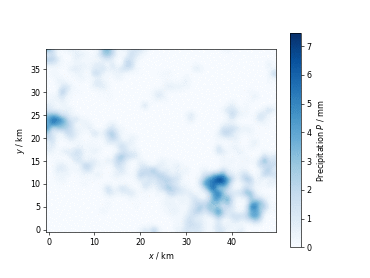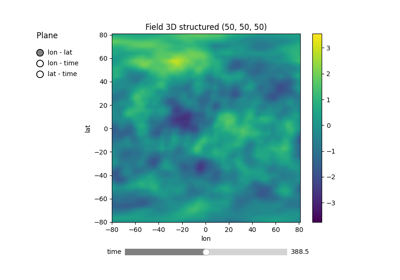Spatio-Temporal Modeling
Spatio-Temporal modelling can provide insights into time dependent processes like rainfall, air temperature or crop yield.
GSTools provides the metric spatio-temporal model for all covariance models
by setting temporal=True, which enhances the spatial model dimension with
a time dimension to result in the spatio-temporal dimension.
Since the model dimension is then higher than the spatial dimension, you can use
the spatial_dim argument to explicitly set the spatial dimension.
Doing that and setting a spatio-temporal anisotropy ratio looks like this:
import gstools as gs
dim = 3 # spatial dimension
st_anis = 0.4
st_model = gs.Exponential(temporal=True, spatial_dim=dim, anis=st_anis)
Since it is given in the name “spatio-temporal”, time is always treated as last dimension.
You could also use dim to specify the dimension but note that it needs to include
the temporal dimension.
There are now three different dimension attributes giving information about (i) the
model dimension (dim), (ii) the field dimension (field_dim, including time) and
(iii) the spatial dimension (spatial_dim always 1 less than field_dim for temporal models).
Model and field dimension can differ in case of geographic coordinates where the model dimension is 3,
but the field or parametric dimension is 2.
If the model is spatio-temporal with geographic coordinates, the model dimension is 4,
the field dimension is 3 and the spatial dimension is 2.
In the case above we get:
st_model.dim == 4
st_model.field_dim == 4
st_model.spatial_dim == 3
This formulation enables us to have spatial anisotropy and rotation defined as in non-temporal models, without altering the behavior in the time dimension:
anis = [0.4, 0.2] # spatial anisotropy in 3D
angles = [0.5, 0.4, 0.3] # spatial rotation in 3D
st_model = gs.Exponential(temporal=True, spatial_dim=dim, anis=anis+[st_anis], angles=angles)
In order to generate spatio-temporal position tuples, GSTools provides a
convenient function generate_st_grid. The output can be used for
spatio-temporal random field generation (or kriging resp. conditioned fields):
pos = dim * [1, 2, 3] # 3 points in space (1,1,1), (2,2,2) and (3,3,3)
time = range(10) # 10 time steps
st_grid = gs.generate_st_grid(pos, time)
st_rf = gs.SRF(st_model)
st_field = st_rf(st_grid).reshape(-1, len(time))
Then we can access the different time-steps by the last array index.


